Enterprise Systems’ Integration with Internet of Things Analysis
VerifiedAdded on 2020/04/07
|19
|4666
|33
Report
AI Summary
This report provides a comprehensive analysis of the integration between Enterprise Systems and the Internet of Things (IoT). It begins with an introduction to the Enterprise IoT and its growing importance in modern business, highlighting its ability to improve efficiency and streamline processes. The report then delves into the specifics of how Enterprise Systems are integrating with IoT, discussing the impact of IoT on decision-making, data acquisition, and IT infrastructure. A significant portion of the report is dedicated to a case study of Amazon Fresh's Dash Program, illustrating how IoT technologies are transforming e-commerce, customer behavior, and predictive analytics. Furthermore, the report explores the concept of customer retention through automated services, the integration of e-commerce, IoT, and line-of-business applications, and the challenges businesses face as they move forward with IoT adoption. The report concludes with an overview of how Amazon is handling technology and offers insights into the future of IoT integration in various industries.

Running head: ENTERPRISE SYSTEMS’ INTEGRATION WITH INTERNET OF THINGS
Enterprise Systems’ integration with Internet of Things
Name of the student:
Name of the university:
Author Note
Enterprise Systems’ integration with Internet of Things
Name of the student:
Name of the university:
Author Note
Paraphrase This Document
Need a fresh take? Get an instant paraphrase of this document with our AI Paraphraser

1Running head: ENTERPRISE SYSTEMS’ INTEGRATION WITH INTERNET OF THINGS
Executive summary
The Enterprise Internet of Things or IoT has been denoted as the upcoming development in
the technology enabling the physical things. The report discusses on the integration of the
Enterprise systems with the IoT. Moreover, it has also made chosen Amazon Fresh’s Dash
Program as a relevant case study for the understanding of the Enterprise Systems’
integration with the Internet of Things.
Executive summary
The Enterprise Internet of Things or IoT has been denoted as the upcoming development in
the technology enabling the physical things. The report discusses on the integration of the
Enterprise systems with the IoT. Moreover, it has also made chosen Amazon Fresh’s Dash
Program as a relevant case study for the understanding of the Enterprise Systems’
integration with the Internet of Things.
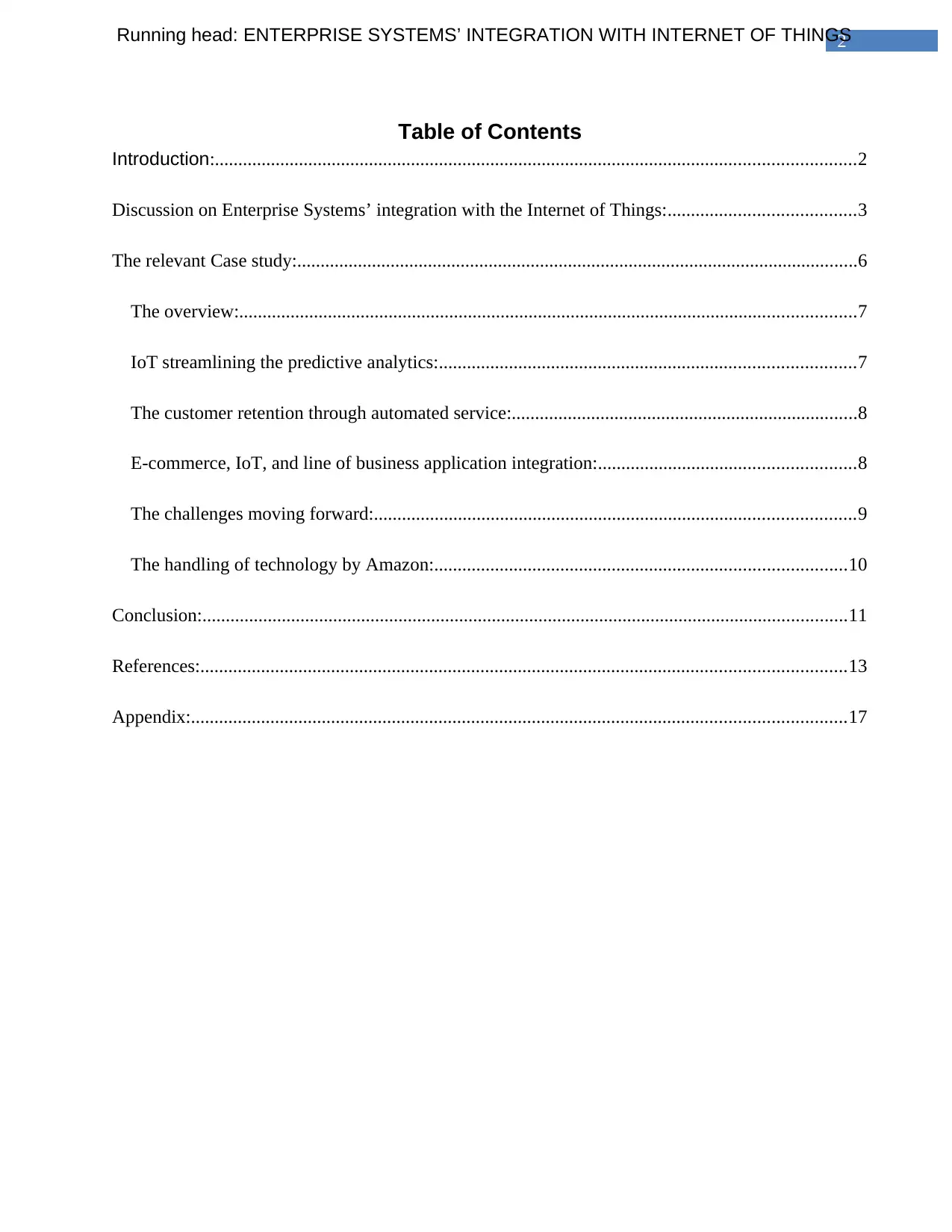
2Running head: ENTERPRISE SYSTEMS’ INTEGRATION WITH INTERNET OF THINGS
Table of Contents
Introduction:.........................................................................................................................................2
Discussion on Enterprise Systems’ integration with the Internet of Things:........................................3
The relevant Case study:........................................................................................................................6
The overview:....................................................................................................................................7
IoT streamlining the predictive analytics:.........................................................................................7
The customer retention through automated service:..........................................................................8
E-commerce, IoT, and line of business application integration:.......................................................8
The challenges moving forward:.......................................................................................................9
The handling of technology by Amazon:........................................................................................10
Conclusion:..........................................................................................................................................11
References:..........................................................................................................................................13
Appendix:............................................................................................................................................17
Table of Contents
Introduction:.........................................................................................................................................2
Discussion on Enterprise Systems’ integration with the Internet of Things:........................................3
The relevant Case study:........................................................................................................................6
The overview:....................................................................................................................................7
IoT streamlining the predictive analytics:.........................................................................................7
The customer retention through automated service:..........................................................................8
E-commerce, IoT, and line of business application integration:.......................................................8
The challenges moving forward:.......................................................................................................9
The handling of technology by Amazon:........................................................................................10
Conclusion:..........................................................................................................................................11
References:..........................................................................................................................................13
Appendix:............................................................................................................................................17
⊘ This is a preview!⊘
Do you want full access?
Subscribe today to unlock all pages.

Trusted by 1+ million students worldwide
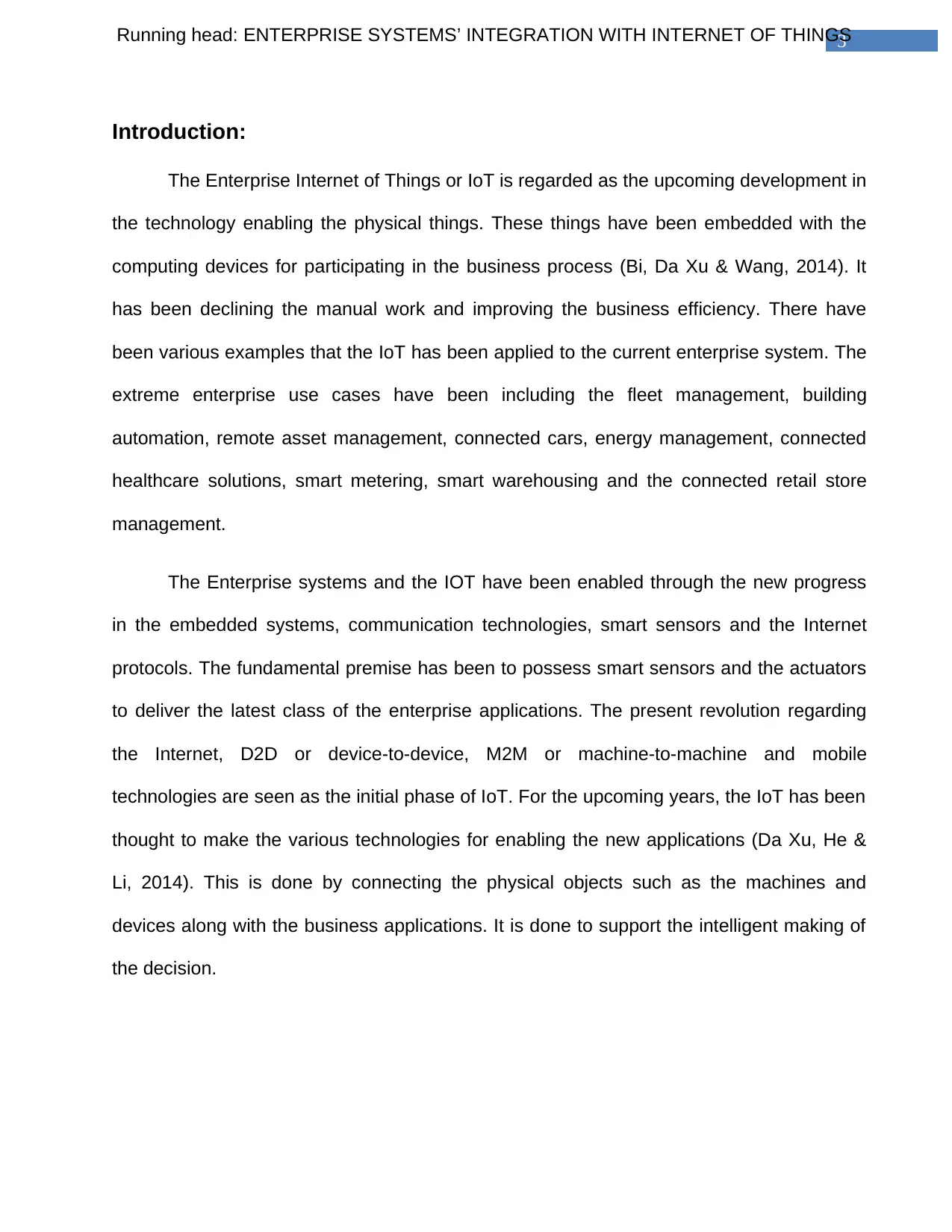
3Running head: ENTERPRISE SYSTEMS’ INTEGRATION WITH INTERNET OF THINGS
Introduction:
The Enterprise Internet of Things or IoT is regarded as the upcoming development in
the technology enabling the physical things. These things have been embedded with the
computing devices for participating in the business process (Bi, Da Xu & Wang, 2014). It
has been declining the manual work and improving the business efficiency. There have
been various examples that the IoT has been applied to the current enterprise system. The
extreme enterprise use cases have been including the fleet management, building
automation, remote asset management, connected cars, energy management, connected
healthcare solutions, smart metering, smart warehousing and the connected retail store
management.
The Enterprise systems and the IOT have been enabled through the new progress
in the embedded systems, communication technologies, smart sensors and the Internet
protocols. The fundamental premise has been to possess smart sensors and the actuators
to deliver the latest class of the enterprise applications. The present revolution regarding
the Internet, D2D or device-to-device, M2M or machine-to-machine and mobile
technologies are seen as the initial phase of IoT. For the upcoming years, the IoT has been
thought to make the various technologies for enabling the new applications (Da Xu, He &
Li, 2014). This is done by connecting the physical objects such as the machines and
devices along with the business applications. It is done to support the intelligent making of
the decision.
Introduction:
The Enterprise Internet of Things or IoT is regarded as the upcoming development in
the technology enabling the physical things. These things have been embedded with the
computing devices for participating in the business process (Bi, Da Xu & Wang, 2014). It
has been declining the manual work and improving the business efficiency. There have
been various examples that the IoT has been applied to the current enterprise system. The
extreme enterprise use cases have been including the fleet management, building
automation, remote asset management, connected cars, energy management, connected
healthcare solutions, smart metering, smart warehousing and the connected retail store
management.
The Enterprise systems and the IOT have been enabled through the new progress
in the embedded systems, communication technologies, smart sensors and the Internet
protocols. The fundamental premise has been to possess smart sensors and the actuators
to deliver the latest class of the enterprise applications. The present revolution regarding
the Internet, D2D or device-to-device, M2M or machine-to-machine and mobile
technologies are seen as the initial phase of IoT. For the upcoming years, the IoT has been
thought to make the various technologies for enabling the new applications (Da Xu, He &
Li, 2014). This is done by connecting the physical objects such as the machines and
devices along with the business applications. It is done to support the intelligent making of
the decision.
Paraphrase This Document
Need a fresh take? Get an instant paraphrase of this document with our AI Paraphraser

4Running head: ENTERPRISE SYSTEMS’ INTEGRATION WITH INTERNET OF THINGS
The following report deals with the discussion on the integration of the Enterprise
systems with the IoT. It has also made chosen Amazon Fresh’s Dash Program as a
relevant case study for the understanding of the topic.
Discussion on Enterprise Systems’ integration with the Internet of
Things:
The operation and design of the manufacturing enterprise have been involving with
various kinds of decision-making at different domains and levels. The complicated system
has possessed a huge number of decision-making and design variable needing the real-
time data gathered from the business scenario, processes, and machines. The ES has
been used for supporting the data acquisition, decision-making tasks (Tao et al., 2014).
Thus the IT infrastructure for the sharing effects and acquisition has been impacting the
performance of ES highly. Investigations are done highly on the effect of the growing IoT on
the Es on the modern technologies. For achieving this, the development of the paradigms
of the manufacturing system is needed to recognize necessities of the decision support
systems in the distributed and the dynamic scenarios. This also includes the latest
advances in IT associated and overviewed with the paradigms of net generation
manufacturing. This also includes the relation of the ES and the IR infrastructure. These
have been explored in the marketplace to recognize the gaps to adopt the IoT as the
infrastructure of It of ES.
The developing numbers of the physical objects have been connected to IoT at the
unprecedented rate. It is done by realizing the concept of IoT. It has been delivering the
promising scope to create the effective enterprise and industrial systems. This is done by
leveraging the rising ubiquity of the identification of radio-frequency. It has been also
The following report deals with the discussion on the integration of the Enterprise
systems with the IoT. It has also made chosen Amazon Fresh’s Dash Program as a
relevant case study for the understanding of the topic.
Discussion on Enterprise Systems’ integration with the Internet of
Things:
The operation and design of the manufacturing enterprise have been involving with
various kinds of decision-making at different domains and levels. The complicated system
has possessed a huge number of decision-making and design variable needing the real-
time data gathered from the business scenario, processes, and machines. The ES has
been used for supporting the data acquisition, decision-making tasks (Tao et al., 2014).
Thus the IT infrastructure for the sharing effects and acquisition has been impacting the
performance of ES highly. Investigations are done highly on the effect of the growing IoT on
the Es on the modern technologies. For achieving this, the development of the paradigms
of the manufacturing system is needed to recognize necessities of the decision support
systems in the distributed and the dynamic scenarios. This also includes the latest
advances in IT associated and overviewed with the paradigms of net generation
manufacturing. This also includes the relation of the ES and the IR infrastructure. These
have been explored in the marketplace to recognize the gaps to adopt the IoT as the
infrastructure of It of ES.
The developing numbers of the physical objects have been connected to IoT at the
unprecedented rate. It is done by realizing the concept of IoT. It has been delivering the
promising scope to create the effective enterprise and industrial systems. This is done by
leveraging the rising ubiquity of the identification of radio-frequency. It has been also
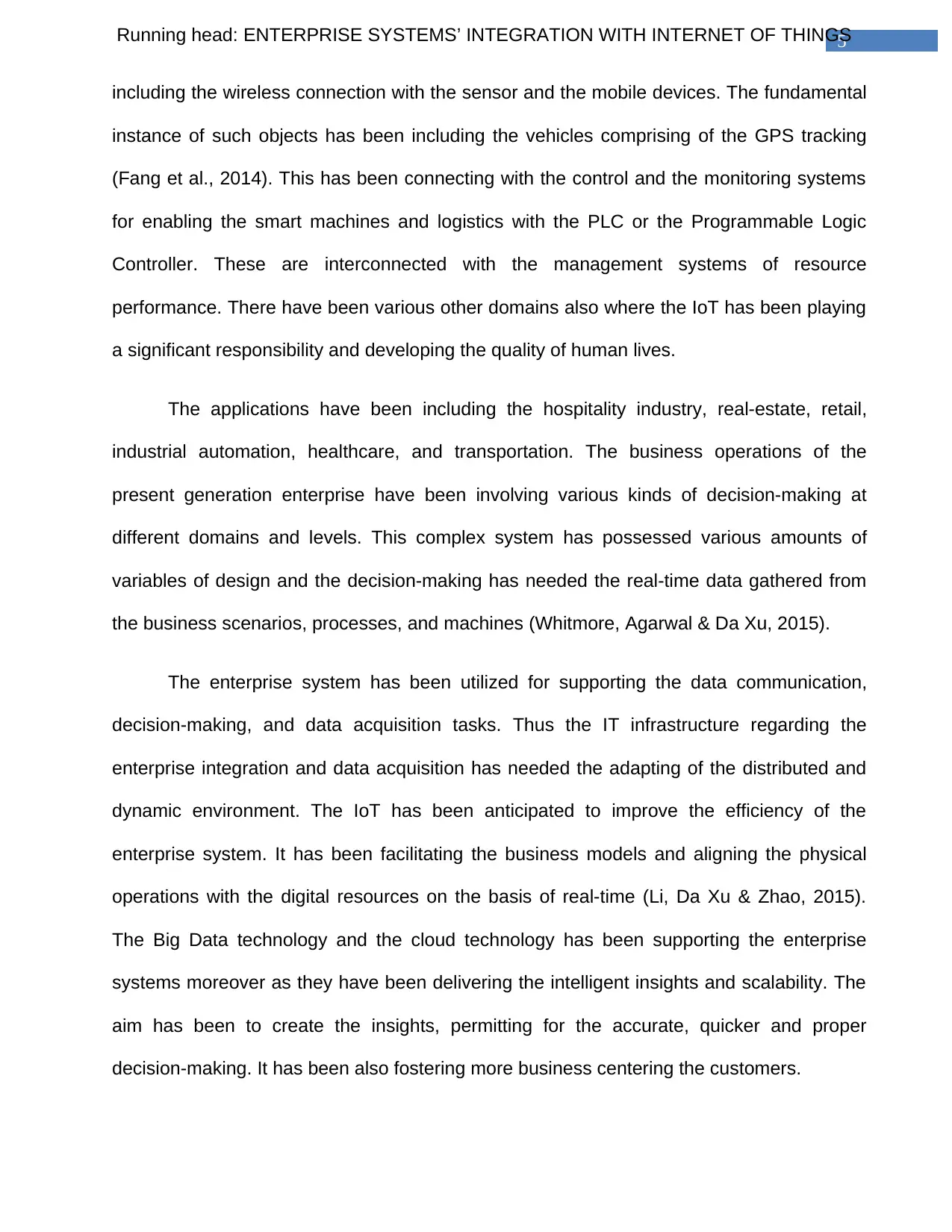
5Running head: ENTERPRISE SYSTEMS’ INTEGRATION WITH INTERNET OF THINGS
including the wireless connection with the sensor and the mobile devices. The fundamental
instance of such objects has been including the vehicles comprising of the GPS tracking
(Fang et al., 2014). This has been connecting with the control and the monitoring systems
for enabling the smart machines and logistics with the PLC or the Programmable Logic
Controller. These are interconnected with the management systems of resource
performance. There have been various other domains also where the IoT has been playing
a significant responsibility and developing the quality of human lives.
The applications have been including the hospitality industry, real-estate, retail,
industrial automation, healthcare, and transportation. The business operations of the
present generation enterprise have been involving various kinds of decision-making at
different domains and levels. This complex system has possessed various amounts of
variables of design and the decision-making has needed the real-time data gathered from
the business scenarios, processes, and machines (Whitmore, Agarwal & Da Xu, 2015).
The enterprise system has been utilized for supporting the data communication,
decision-making, and data acquisition tasks. Thus the IT infrastructure regarding the
enterprise integration and data acquisition has needed the adapting of the distributed and
dynamic environment. The IoT has been anticipated to improve the efficiency of the
enterprise system. It has been facilitating the business models and aligning the physical
operations with the digital resources on the basis of real-time (Li, Da Xu & Zhao, 2015).
The Big Data technology and the cloud technology has been supporting the enterprise
systems moreover as they have been delivering the intelligent insights and scalability. The
aim has been to create the insights, permitting for the accurate, quicker and proper
decision-making. It has been also fostering more business centering the customers.
including the wireless connection with the sensor and the mobile devices. The fundamental
instance of such objects has been including the vehicles comprising of the GPS tracking
(Fang et al., 2014). This has been connecting with the control and the monitoring systems
for enabling the smart machines and logistics with the PLC or the Programmable Logic
Controller. These are interconnected with the management systems of resource
performance. There have been various other domains also where the IoT has been playing
a significant responsibility and developing the quality of human lives.
The applications have been including the hospitality industry, real-estate, retail,
industrial automation, healthcare, and transportation. The business operations of the
present generation enterprise have been involving various kinds of decision-making at
different domains and levels. This complex system has possessed various amounts of
variables of design and the decision-making has needed the real-time data gathered from
the business scenarios, processes, and machines (Whitmore, Agarwal & Da Xu, 2015).
The enterprise system has been utilized for supporting the data communication,
decision-making, and data acquisition tasks. Thus the IT infrastructure regarding the
enterprise integration and data acquisition has needed the adapting of the distributed and
dynamic environment. The IoT has been anticipated to improve the efficiency of the
enterprise system. It has been facilitating the business models and aligning the physical
operations with the digital resources on the basis of real-time (Li, Da Xu & Zhao, 2015).
The Big Data technology and the cloud technology has been supporting the enterprise
systems moreover as they have been delivering the intelligent insights and scalability. The
aim has been to create the insights, permitting for the accurate, quicker and proper
decision-making. It has been also fostering more business centering the customers.
⊘ This is a preview!⊘
Do you want full access?
Subscribe today to unlock all pages.

Trusted by 1+ million students worldwide

6Running head: ENTERPRISE SYSTEMS’ INTEGRATION WITH INTERNET OF THINGS
There have been various instances that have been applied to IoT in the current IoT
system. Various platforms of the Enterprise Systems have been integrating with the ERP,
MRP and the systems of business intelligence for delivering the most helpful insights for
the decision makers. They have been implemented as the part of the IoT strategy along
with the integration of the EAI or Enterprise Application Integration projects (Pang et al.,
2015). As the platforms have been achieving the attention for their end-to-end offerings
with their IoT solutions, they have been helping the companies to connect the devices. This
has been to acquire the data that has been relevant for the enterprise systems and the
same time delivering the controls to the enterprise systems to control those devices.
Most of the enterprises have been adapting to the IoT applications for saving the
expenses. For instance, they have needed to reduce the usage of energy, reducing the
chance of theft or reducing the probability of failure of the factory equipment. Despite all
this, few enterprises have been utilizing the IoT for developing the new services. The
construction and the manufacturing organizations have been using the IoT. This is done to
develop the safety through launching the services of collision-avoidance. It reduces the
injuries and accidents at sites (He & Da Xu, 2014). Moreover, the automotive
manufacturers have been embedding the connectivity in their products. Hence the cars
could notify the drivers as there is the time for the medical device manufacturers, tune-ups
launching the new healthcare services with the connected products.
The IoT has been playing the primary role in the enterprise systems with the proper
level of integration. Thus The IoT could act as the bridge between the IT infrastructure and
the physical assets. The IoT of enterprise has been improving the efficiency of the material
resource plan and the supply chain management. With the tracking of assets, remote
There have been various instances that have been applied to IoT in the current IoT
system. Various platforms of the Enterprise Systems have been integrating with the ERP,
MRP and the systems of business intelligence for delivering the most helpful insights for
the decision makers. They have been implemented as the part of the IoT strategy along
with the integration of the EAI or Enterprise Application Integration projects (Pang et al.,
2015). As the platforms have been achieving the attention for their end-to-end offerings
with their IoT solutions, they have been helping the companies to connect the devices. This
has been to acquire the data that has been relevant for the enterprise systems and the
same time delivering the controls to the enterprise systems to control those devices.
Most of the enterprises have been adapting to the IoT applications for saving the
expenses. For instance, they have needed to reduce the usage of energy, reducing the
chance of theft or reducing the probability of failure of the factory equipment. Despite all
this, few enterprises have been utilizing the IoT for developing the new services. The
construction and the manufacturing organizations have been using the IoT. This is done to
develop the safety through launching the services of collision-avoidance. It reduces the
injuries and accidents at sites (He & Da Xu, 2014). Moreover, the automotive
manufacturers have been embedding the connectivity in their products. Hence the cars
could notify the drivers as there is the time for the medical device manufacturers, tune-ups
launching the new healthcare services with the connected products.
The IoT has been playing the primary role in the enterprise systems with the proper
level of integration. Thus The IoT could act as the bridge between the IT infrastructure and
the physical assets. The IoT of enterprise has been improving the efficiency of the material
resource plan and the supply chain management. With the tracking of assets, remote
Paraphrase This Document
Need a fresh take? Get an instant paraphrase of this document with our AI Paraphraser
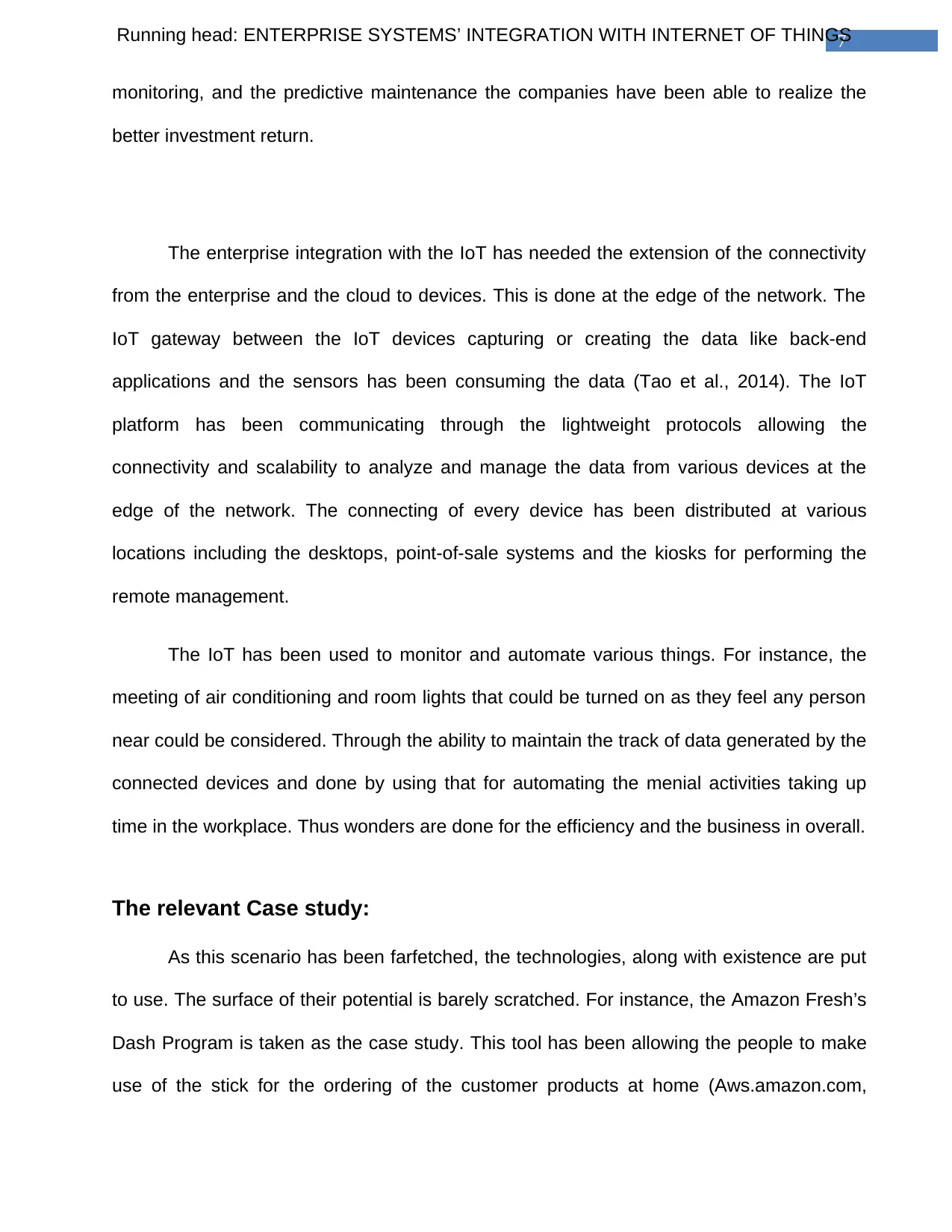
7Running head: ENTERPRISE SYSTEMS’ INTEGRATION WITH INTERNET OF THINGS
monitoring, and the predictive maintenance the companies have been able to realize the
better investment return.
The enterprise integration with the IoT has needed the extension of the connectivity
from the enterprise and the cloud to devices. This is done at the edge of the network. The
IoT gateway between the IoT devices capturing or creating the data like back-end
applications and the sensors has been consuming the data (Tao et al., 2014). The IoT
platform has been communicating through the lightweight protocols allowing the
connectivity and scalability to analyze and manage the data from various devices at the
edge of the network. The connecting of every device has been distributed at various
locations including the desktops, point-of-sale systems and the kiosks for performing the
remote management.
The IoT has been used to monitor and automate various things. For instance, the
meeting of air conditioning and room lights that could be turned on as they feel any person
near could be considered. Through the ability to maintain the track of data generated by the
connected devices and done by using that for automating the menial activities taking up
time in the workplace. Thus wonders are done for the efficiency and the business in overall.
The relevant Case study:
As this scenario has been farfetched, the technologies, along with existence are put
to use. The surface of their potential is barely scratched. For instance, the Amazon Fresh’s
Dash Program is taken as the case study. This tool has been allowing the people to make
use of the stick for the ordering of the customer products at home (Aws.amazon.com,
monitoring, and the predictive maintenance the companies have been able to realize the
better investment return.
The enterprise integration with the IoT has needed the extension of the connectivity
from the enterprise and the cloud to devices. This is done at the edge of the network. The
IoT gateway between the IoT devices capturing or creating the data like back-end
applications and the sensors has been consuming the data (Tao et al., 2014). The IoT
platform has been communicating through the lightweight protocols allowing the
connectivity and scalability to analyze and manage the data from various devices at the
edge of the network. The connecting of every device has been distributed at various
locations including the desktops, point-of-sale systems and the kiosks for performing the
remote management.
The IoT has been used to monitor and automate various things. For instance, the
meeting of air conditioning and room lights that could be turned on as they feel any person
near could be considered. Through the ability to maintain the track of data generated by the
connected devices and done by using that for automating the menial activities taking up
time in the workplace. Thus wonders are done for the efficiency and the business in overall.
The relevant Case study:
As this scenario has been farfetched, the technologies, along with existence are put
to use. The surface of their potential is barely scratched. For instance, the Amazon Fresh’s
Dash Program is taken as the case study. This tool has been allowing the people to make
use of the stick for the ordering of the customer products at home (Aws.amazon.com,
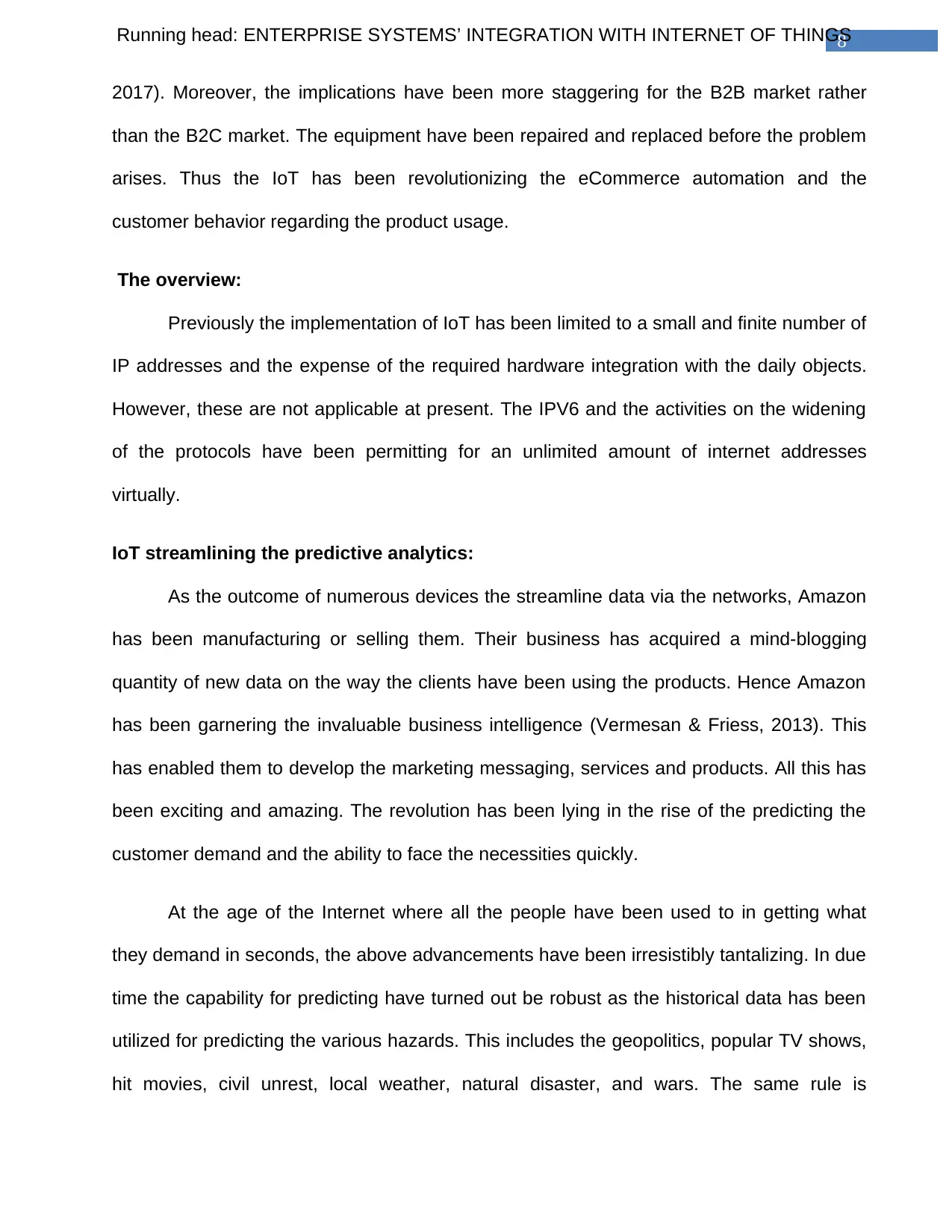
8Running head: ENTERPRISE SYSTEMS’ INTEGRATION WITH INTERNET OF THINGS
2017). Moreover, the implications have been more staggering for the B2B market rather
than the B2C market. The equipment have been repaired and replaced before the problem
arises. Thus the IoT has been revolutionizing the eCommerce automation and the
customer behavior regarding the product usage.
The overview:
Previously the implementation of IoT has been limited to a small and finite number of
IP addresses and the expense of the required hardware integration with the daily objects.
However, these are not applicable at present. The IPV6 and the activities on the widening
of the protocols have been permitting for an unlimited amount of internet addresses
virtually.
IoT streamlining the predictive analytics:
As the outcome of numerous devices the streamline data via the networks, Amazon
has been manufacturing or selling them. Their business has acquired a mind-blogging
quantity of new data on the way the clients have been using the products. Hence Amazon
has been garnering the invaluable business intelligence (Vermesan & Friess, 2013). This
has enabled them to develop the marketing messaging, services and products. All this has
been exciting and amazing. The revolution has been lying in the rise of the predicting the
customer demand and the ability to face the necessities quickly.
At the age of the Internet where all the people have been used to in getting what
they demand in seconds, the above advancements have been irresistibly tantalizing. In due
time the capability for predicting have turned out be robust as the historical data has been
utilized for predicting the various hazards. This includes the geopolitics, popular TV shows,
hit movies, civil unrest, local weather, natural disaster, and wars. The same rule is
2017). Moreover, the implications have been more staggering for the B2B market rather
than the B2C market. The equipment have been repaired and replaced before the problem
arises. Thus the IoT has been revolutionizing the eCommerce automation and the
customer behavior regarding the product usage.
The overview:
Previously the implementation of IoT has been limited to a small and finite number of
IP addresses and the expense of the required hardware integration with the daily objects.
However, these are not applicable at present. The IPV6 and the activities on the widening
of the protocols have been permitting for an unlimited amount of internet addresses
virtually.
IoT streamlining the predictive analytics:
As the outcome of numerous devices the streamline data via the networks, Amazon
has been manufacturing or selling them. Their business has acquired a mind-blogging
quantity of new data on the way the clients have been using the products. Hence Amazon
has been garnering the invaluable business intelligence (Vermesan & Friess, 2013). This
has enabled them to develop the marketing messaging, services and products. All this has
been exciting and amazing. The revolution has been lying in the rise of the predicting the
customer demand and the ability to face the necessities quickly.
At the age of the Internet where all the people have been used to in getting what
they demand in seconds, the above advancements have been irresistibly tantalizing. In due
time the capability for predicting have turned out be robust as the historical data has been
utilized for predicting the various hazards. This includes the geopolitics, popular TV shows,
hit movies, civil unrest, local weather, natural disaster, and wars. The same rule is
⊘ This is a preview!⊘
Do you want full access?
Subscribe today to unlock all pages.

Trusted by 1+ million students worldwide
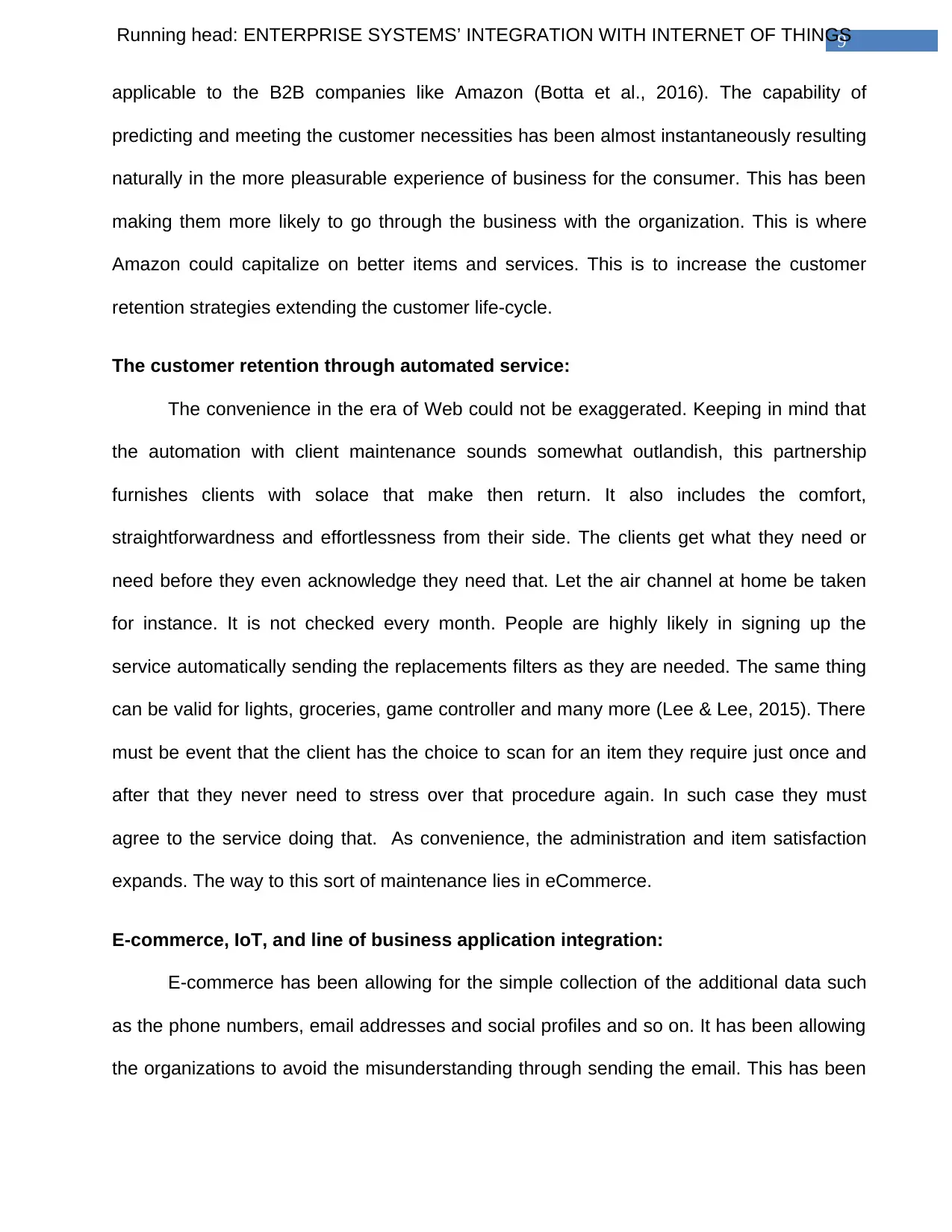
9Running head: ENTERPRISE SYSTEMS’ INTEGRATION WITH INTERNET OF THINGS
applicable to the B2B companies like Amazon (Botta et al., 2016). The capability of
predicting and meeting the customer necessities has been almost instantaneously resulting
naturally in the more pleasurable experience of business for the consumer. This has been
making them more likely to go through the business with the organization. This is where
Amazon could capitalize on better items and services. This is to increase the customer
retention strategies extending the customer life-cycle.
The customer retention through automated service:
The convenience in the era of Web could not be exaggerated. Keeping in mind that
the automation with client maintenance sounds somewhat outlandish, this partnership
furnishes clients with solace that make then return. It also includes the comfort,
straightforwardness and effortlessness from their side. The clients get what they need or
need before they even acknowledge they need that. Let the air channel at home be taken
for instance. It is not checked every month. People are highly likely in signing up the
service automatically sending the replacements filters as they are needed. The same thing
can be valid for lights, groceries, game controller and many more (Lee & Lee, 2015). There
must be event that the client has the choice to scan for an item they require just once and
after that they never need to stress over that procedure again. In such case they must
agree to the service doing that. As convenience, the administration and item satisfaction
expands. The way to this sort of maintenance lies in eCommerce.
E-commerce, IoT, and line of business application integration:
E-commerce has been allowing for the simple collection of the additional data such
as the phone numbers, email addresses and social profiles and so on. It has been allowing
the organizations to avoid the misunderstanding through sending the email. This has been
applicable to the B2B companies like Amazon (Botta et al., 2016). The capability of
predicting and meeting the customer necessities has been almost instantaneously resulting
naturally in the more pleasurable experience of business for the consumer. This has been
making them more likely to go through the business with the organization. This is where
Amazon could capitalize on better items and services. This is to increase the customer
retention strategies extending the customer life-cycle.
The customer retention through automated service:
The convenience in the era of Web could not be exaggerated. Keeping in mind that
the automation with client maintenance sounds somewhat outlandish, this partnership
furnishes clients with solace that make then return. It also includes the comfort,
straightforwardness and effortlessness from their side. The clients get what they need or
need before they even acknowledge they need that. Let the air channel at home be taken
for instance. It is not checked every month. People are highly likely in signing up the
service automatically sending the replacements filters as they are needed. The same thing
can be valid for lights, groceries, game controller and many more (Lee & Lee, 2015). There
must be event that the client has the choice to scan for an item they require just once and
after that they never need to stress over that procedure again. In such case they must
agree to the service doing that. As convenience, the administration and item satisfaction
expands. The way to this sort of maintenance lies in eCommerce.
E-commerce, IoT, and line of business application integration:
E-commerce has been allowing for the simple collection of the additional data such
as the phone numbers, email addresses and social profiles and so on. It has been allowing
the organizations to avoid the misunderstanding through sending the email. This has been
Paraphrase This Document
Need a fresh take? Get an instant paraphrase of this document with our AI Paraphraser
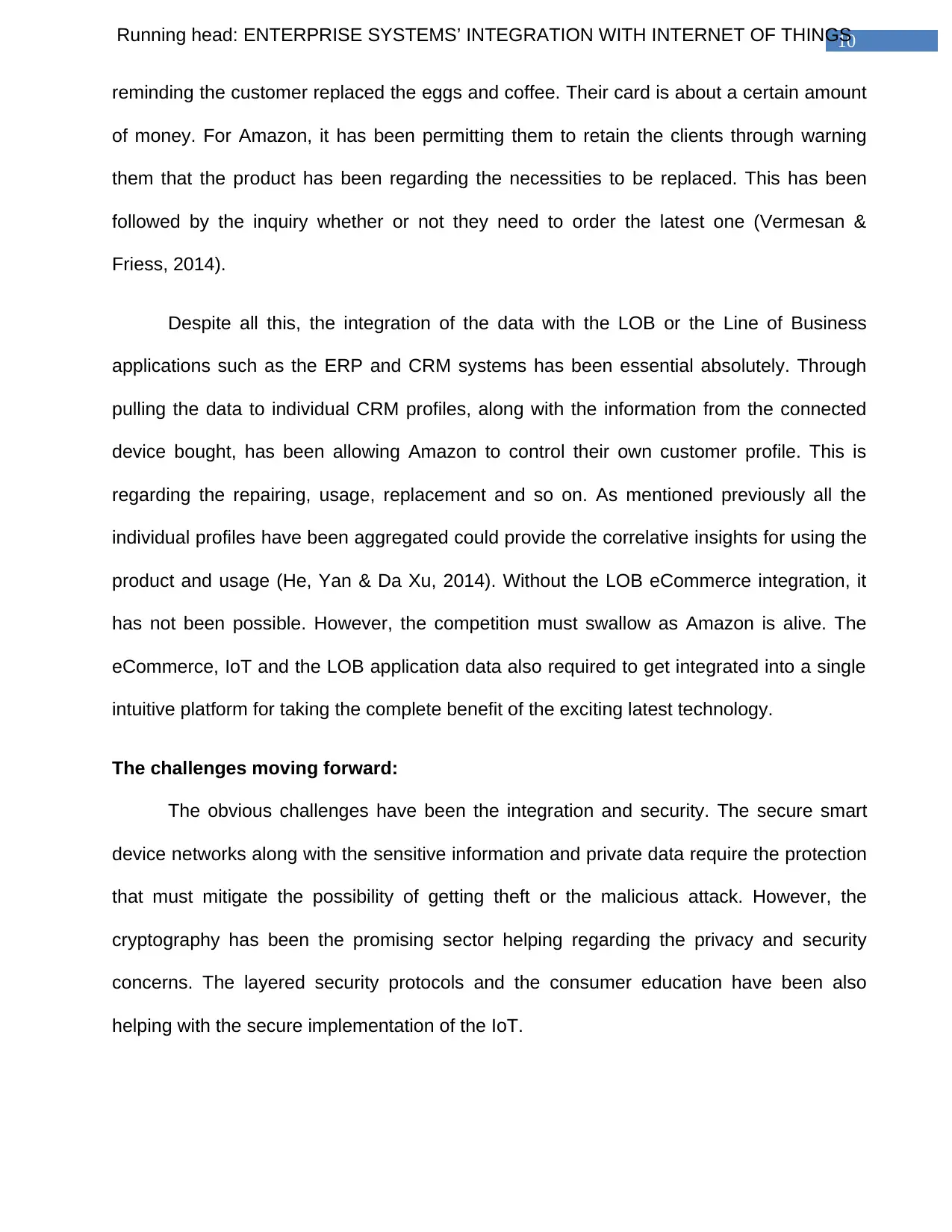
10Running head: ENTERPRISE SYSTEMS’ INTEGRATION WITH INTERNET OF THINGS
reminding the customer replaced the eggs and coffee. Their card is about a certain amount
of money. For Amazon, it has been permitting them to retain the clients through warning
them that the product has been regarding the necessities to be replaced. This has been
followed by the inquiry whether or not they need to order the latest one (Vermesan &
Friess, 2014).
Despite all this, the integration of the data with the LOB or the Line of Business
applications such as the ERP and CRM systems has been essential absolutely. Through
pulling the data to individual CRM profiles, along with the information from the connected
device bought, has been allowing Amazon to control their own customer profile. This is
regarding the repairing, usage, replacement and so on. As mentioned previously all the
individual profiles have been aggregated could provide the correlative insights for using the
product and usage (He, Yan & Da Xu, 2014). Without the LOB eCommerce integration, it
has not been possible. However, the competition must swallow as Amazon is alive. The
eCommerce, IoT and the LOB application data also required to get integrated into a single
intuitive platform for taking the complete benefit of the exciting latest technology.
The challenges moving forward:
The obvious challenges have been the integration and security. The secure smart
device networks along with the sensitive information and private data require the protection
that must mitigate the possibility of getting theft or the malicious attack. However, the
cryptography has been the promising sector helping regarding the privacy and security
concerns. The layered security protocols and the consumer education have been also
helping with the secure implementation of the IoT.
reminding the customer replaced the eggs and coffee. Their card is about a certain amount
of money. For Amazon, it has been permitting them to retain the clients through warning
them that the product has been regarding the necessities to be replaced. This has been
followed by the inquiry whether or not they need to order the latest one (Vermesan &
Friess, 2014).
Despite all this, the integration of the data with the LOB or the Line of Business
applications such as the ERP and CRM systems has been essential absolutely. Through
pulling the data to individual CRM profiles, along with the information from the connected
device bought, has been allowing Amazon to control their own customer profile. This is
regarding the repairing, usage, replacement and so on. As mentioned previously all the
individual profiles have been aggregated could provide the correlative insights for using the
product and usage (He, Yan & Da Xu, 2014). Without the LOB eCommerce integration, it
has not been possible. However, the competition must swallow as Amazon is alive. The
eCommerce, IoT and the LOB application data also required to get integrated into a single
intuitive platform for taking the complete benefit of the exciting latest technology.
The challenges moving forward:
The obvious challenges have been the integration and security. The secure smart
device networks along with the sensitive information and private data require the protection
that must mitigate the possibility of getting theft or the malicious attack. However, the
cryptography has been the promising sector helping regarding the privacy and security
concerns. The layered security protocols and the consumer education have been also
helping with the secure implementation of the IoT.

11Running head: ENTERPRISE SYSTEMS’ INTEGRATION WITH INTERNET OF THINGS
The integration has been difficult for most of the business. The organizations have
been worrying regarding the complete expense over time, the ability to adapt and scale.
The IT resources have been required to control the system, to deploy and kept secured.
Moreover, the integration of the IoT integration with the LOB systems and e-commerce has
needed the custom integration (Botta et al., 2014). At last, it has been coming down to
Amazon building the custom integration. Thus the IoT at Amazon has been a significant
technological revolution with full of benefits to the day of their clients and the way they do
business. Amazon has been taking the complete advantage of it and hence the rewards
have been limitless.
The handling of technology by Amazon:
The partnership of Amazon with the clients has contributed highly to the developing
of few remarkable services and products that have been poised to disrupt the industries
(Chen, Chen & Hsu, 2014). Below is the way how some of the clients have been taking the
cloud services like SaaS world through worm with the helping from the revenue
management platform.
• IAS has been delivering the services and an industry network to Amazon. This has been
to improve the visibility around the transportation of items.
• The Hemisphere GNSS launched Atlas satellite recently. This has been the corrective
positioning service. It featured the industry-disrupting accuracy and pricing.
• The Amplifier is the third-party logistics or 3PL Company. It has been building the quick
growing service of merchandising.
The integration has been difficult for most of the business. The organizations have
been worrying regarding the complete expense over time, the ability to adapt and scale.
The IT resources have been required to control the system, to deploy and kept secured.
Moreover, the integration of the IoT integration with the LOB systems and e-commerce has
needed the custom integration (Botta et al., 2014). At last, it has been coming down to
Amazon building the custom integration. Thus the IoT at Amazon has been a significant
technological revolution with full of benefits to the day of their clients and the way they do
business. Amazon has been taking the complete advantage of it and hence the rewards
have been limitless.
The handling of technology by Amazon:
The partnership of Amazon with the clients has contributed highly to the developing
of few remarkable services and products that have been poised to disrupt the industries
(Chen, Chen & Hsu, 2014). Below is the way how some of the clients have been taking the
cloud services like SaaS world through worm with the helping from the revenue
management platform.
• IAS has been delivering the services and an industry network to Amazon. This has been
to improve the visibility around the transportation of items.
• The Hemisphere GNSS launched Atlas satellite recently. This has been the corrective
positioning service. It featured the industry-disrupting accuracy and pricing.
• The Amplifier is the third-party logistics or 3PL Company. It has been building the quick
growing service of merchandising.
⊘ This is a preview!⊘
Do you want full access?
Subscribe today to unlock all pages.

Trusted by 1+ million students worldwide
1 out of 19
Related Documents
Your All-in-One AI-Powered Toolkit for Academic Success.
+13062052269
info@desklib.com
Available 24*7 on WhatsApp / Email
![[object Object]](/_next/static/media/star-bottom.7253800d.svg)
Unlock your academic potential
Copyright © 2020–2025 A2Z Services. All Rights Reserved. Developed and managed by ZUCOL.




